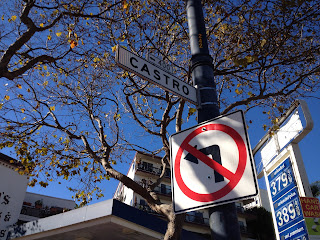After months of exploration in San Francisco, we have reached the end. Our field trips, which have become my favorite part of the week, have been wrapped up. Our final trip was to the Embarcadero, the Ferry Terminal Building, Fisherman’s Wharf and the Piers. As the holidays role around, it is beautiful to tour around the city with the large amounts of christmas lights and wreathes.
The signage directs people to various tourist attractions. All along the piers they have signs with arrows pointing to the major attractions such as Fisherman's Wharf, the Embarcadero and other destinations. It is helpful to have the arrows pointing a person in the direction of the destination, as sometimes it’s hard to know when one must turn to get to the particular place. Also, with every pier you reach there is a sign telling you which particular pier you reach, such a “Pier 27” or “Pier 39.” I personally used this type of signage while walking along the piers. It helped me to know how far I was from both Market Street/ the Embarcadero and Fisherman’s Wharf. In this way the signage was very effective.
The signage directs people to various tourist attractions. All along the piers they have signs with arrows pointing to the major attractions such as Fisherman's Wharf, the Embarcadero and other destinations. It is helpful to have the arrows pointing a person in the direction of the destination, as sometimes it’s hard to know when one must turn to get to the particular place. Also, with every pier you reach there is a sign telling you which particular pier you reach, such a “Pier 27” or “Pier 39.” I personally used this type of signage while walking along the piers. It helped me to know how far I was from both Market Street/ the Embarcadero and Fisherman’s Wharf. In this way the signage was very effective.
A large portion of the signs I saw were for the American Cup. The American Cup is a sailing competition famous all around the world. It brings about the worlds best sailors and yacht designers, but is also popular with wealthy entrepreneurs and sponsors. The race is held in a different areas each time it is held, but this year it is held in our very own San Francisco. Sign upon sign, anywhere from flyers to giant billboards to stores broadcasted this event. It was amazing to see how much investment there was in the signage of this event all around the piers. Something that isn’t a major attractive, but yet an event was so advertised it was hard to ignore.
We divided up as a class and as I have visited Fisherman’s Wharf more times then I could even count, I felt I wanted to spend time in an area that I was less familiar with. I focused much of my time around the Ferry Terminal Building. The large building can be seen all the way down Market Street. This terminal has a 245-foot tall clock tower on top of the building and San Francisco written in giant red lit letters. The inside of the building is a giant marketplace, which I spent time meandering through. The signs in the marketplace tell you what type of shops there are, or what type of restaurants are available to the visitors. The terminal is not only used for the marketplace, it is a terminal for the ferries and boats coming to and from other areas around San Francisco Bay.
Historically, before Golden Gate Bridge and the Bay Bridge were built, the building was the second busiest transit terminal in the world. After the bridges were build, the use of ferries significantly dropped, but the building was used for a train terminal. The condition of the building began to decrease over the years. It began to be less of a grand space for travelers and changed into less used dark corridors. Locals began to grow upset as the access to the piers was obscured as the construction of the Embarcadero Freeway occurred in the 1950’s. Pedestrian access was limited, and the terminal building that stood as a landmark, was obscured. After the large earthquake in 1989, the freeway was demolished. When rebuilding the area, a ground level boulevard was put in place of the freeway which brought back access to the Terminal Building.
Coming from Washington and living directly on the water, it’s alway nice going to a destination where I can see San Francisco Bay. Also interestingly enough, as I have been studying the 49 mile drive, I saw a handful of the signs along my walk from the Ferry Terminal Building to the piers. The piers are all not as popular as Fisherman’s Wharf, but they each provide a beautiful view of the bay. I must say I have enjoyed every minute we have gotten to spend touring the city this semester. It has been an amazing experience week after week. Coming a few months ago and not being that familiar with places in San Francisco other than Union Square and Downtown, this class has introduced me to so much. I am happy to say I now feel like a native in this large, amazing, unique city.



















































